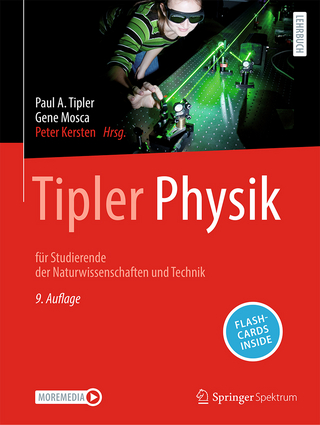
Galactic and Extragalactic Radio Astronomy
Springer-Verlag New York Inc.
978-0-387-97735-5 (ISBN)
- Titel erscheint in neuer Auflage
- Artikel merken
1. Galactic Nonthermal Continuum Emission.- 1.1 Introduction.- 1.2 Physical Processes.- 1.3 Total Intensity Observations of the Galactic Radio Continuum.- 1.4 The Spectrum of the Nonthermal Emission.- 1.5 Linear Polarization of the Nonthermal Emission.- 1.6 The Galactic Nonthermal Radiation in Perspective.- Recommended Reading.- References.- 2. HII Regions and Radio Recombination Lines.- 2.1 Ionized Interstellar Hydrogen.- 2.2 Radiation Transfer.- 2.3 Continuum Thermal Emission (Bremsstrahlung).- 2.4 Basic Theory of Radio Recombination Lines.- 2.5 Refinements to the Transfer Equations.- 2.6 Single-Dish Observations of Radio Recombination Lines from HII Regions.- 2.7 Exploration of the Milky Way by Radio Recombination Lines.- 2.8 Radio Observations of HII Regions with High Angular Resolution.- 2.9 Other Aspects of Radio Recombination Lines.- 2.9.1 Low Frequencies.- 2.9.2 Zeeman Effect.- 2.9.3 The Sun.- 2.9.4 Planetary Nebulae.- 2.9.5 Dark Clouds.- 2.9.6 Galaxies and Quasars.- Recommended Reading.- References.- 3. Neutral Hydrogen and the Diffuse Interstellar Medium.- 3.1 Introduction: Fundamentals.- 3.2 Structure of the Diffuse Interstellar Medium: HI Emission.- 3.3 Temperature and Ionization of the Diffuse Interstellar Medium.- 3.4 Interstellar Magnetic Fields.- 3.5 Summary.- Recommended Reading.- References.- 4. Molecules as Probes of the Interstellar Medium MID of Star Formation.- 4.1 Introduction.- 4.2 The Large-Scale Morphology of the ISM.- 4.3.1 Small Star-Forming Cores in SMCs and GMCs.- 4.4 The Stability of Molecular Clouds and Cores.- 4.5 The Formation of Stars.- 4.6 Future Prospects.- Recommended Reading.- References.- 5. Interstellar Molecules and Astrochemistry.- 5.1 Molecules in Space: An Overview.- 5.2 Where Molecules Are Found: Basic Morphology of the Dense Interstellar Medium.- 5.3 Molecular Abundances and Their Determination.- 5.4 The Four Basic Schemes of Interstellar Chemistry.- 5.5 Current Dilemmas and Future Directions.- Recommended Reading.- References.- 6. Astronomical Masers.- 6.1 Introduction.- 6.2 Maser Theory.- 6.3 Interstellar Masers.- 6.4 Stellar Masers.- 6.5 Extragalactic Masers.- 6.6 Interstellar Scattering.- 6.7 Distance Measurements.- Recommended Reading.- References.- 7. The Structure of Our Galaxy Derived from Observations of Neutral Hydrogen.- 7.1 Observations of Galactic Neutral Hydrogen.- 7.2 Kinematics of Galactic Neutral Hydrogen.- 7.3 Mapping the Galaxy Using Neutral Hydrogen Observations.- 7.4 The Inner-Galaxy Gas Layer.- Recommended Reading.- References.- 8. The Galactic Center.- 8.1 Introduction and Apologia.- 8.2 Radio Continuum Emission from the Provinces of Sagittarius.- 8.3 Sgr A and Its Immediate Environment.- 8.4 Material in Sgr A Observed on 10- to 50-pc Scales.- 8.5 The Neutral Gas Reservoir in the Inner Galactic Regions.- Recommended Reading.- References.- 9. Radio Stars.- 9.1 The Early Years.- 9.2 Fundamental Radio Emission Processes and Stellar Radiative Transfer.- 9.3 Solar Radio Emission.- 9.4 Flare Stars and Active Binaries.- 9.5 Stellar Winds.- 9.6 Cataclysmic Variables.- 9.7 Radio-Emitting X-Ray Binaries.- 9.8 Future Work on Radio Stars.- Recommended Reading.- References.- 10. Supernova Remnants.- 10.1 Introduction.- 10.2 Supernovae.- 10.3 Observed Properties of Supernova Remnants.- 10.4 Theory.- 10.5 Collective Interactions of Supernova Remnants with the Galaxy.- 10.6 Future Prospects.- Recommended Reading.- Catalogues of Galactic Supernova Remnants.- References.- 11. Pulsars.- 11.1 Introduction.- 11.2 Basic Properties.- 11.3 Pulse Morphology and Polarization.- 11.4 IntensityFluctuations.- 11.5 Interstellar Propagation.- 11.6 Timing and Astrometry.- 11.7 Binary and Millisecond Pulsars.- 11.8 Radio Emission Mechanism.- Recommended Reading.- References.- 12. Extragalactic Neutral Hydrogen.- 12.1 Introduction.- 12.2 The Distribution of HI in Galaxies.- 12.3 Velocity Fields.- 12.4 The Velocity Width as a Distance Indicator.- 12.5 HI Content and Other Global Properties.- 12.6 Environmental Effects.- 12.7 Cosmological Studies.- Recommended Reading.- References.- 13. Radio Galaxies and Quasars.- 13.1 Introduction.- 13.2 Low-Luminosity Sources.- 13.3 Compact Sources.- 13.4 Extended Sources.- 13.5 Summary.- Recommended Reading.- References.- 14. The Microwave Background Radiation.- 14.1 Introduction.- 14.2 The Spectrum of the Microwave Background.- 14.3 Polarization of the Microwave Background.- 14.4 Anisotropy Searches.- 14.5 The Sunyaev-Zel’dovich Effect.- Recommended Reading.- References.- 15. Radio Sources and Cosmology.- 15.1 Introduction.- 15.2 Basic Relations.- 15.3 The “World Picture” and Source Evolution.- 15.4 Source Population Data.- 15.5 Evolutionary Models.- 15.6 Source Size Evolution.- 15.7 The Faint-Source Population.- 15.8 Isotropy and Homogeneity.- 15.9 Cosmology Made Simple: The Shell Model.- 15.10 What Next?.- Recommended Reading.- References.
| Reihe/Serie | Astronomy and Astrophysics Library |
|---|---|
| Mitarbeit |
Stellvertretende Herausgeber: E. Bouton |
| Zusatzinfo | XXII, 694 p. |
| Verlagsort | New York, NY |
| Sprache | englisch |
| Maße | 155 x 235 mm |
| Themenwelt | Naturwissenschaften ► Physik / Astronomie ► Allgemeines / Lexika |
| Naturwissenschaften ► Physik / Astronomie ► Astronomie / Astrophysik | |
| ISBN-10 | 0-387-97735-X / 038797735X |
| ISBN-13 | 978-0-387-97735-5 / 9780387977355 |
| Zustand | Neuware |
| Haben Sie eine Frage zum Produkt? |
aus dem Bereich



